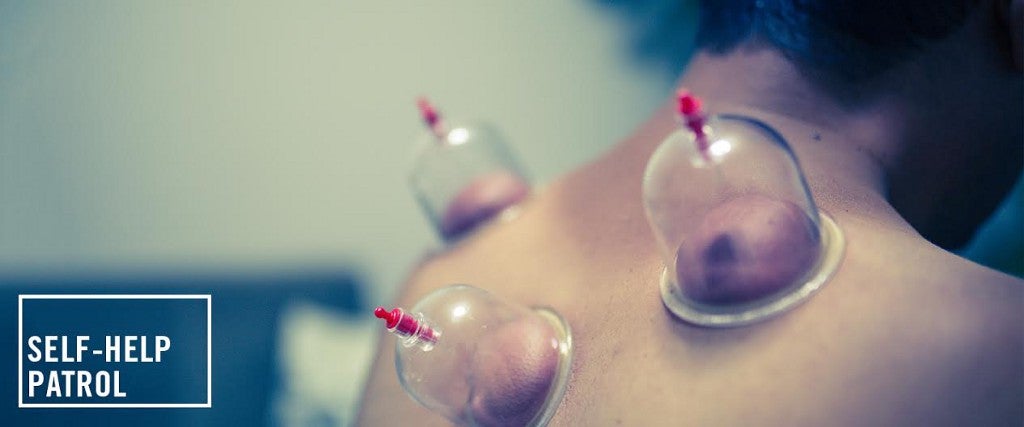World-class athletes are known for their willingness to embrace extreme training regimens and unorthodox treatments in their pursuits of physical excellence — treatments that often look a little outlandish to the mere mortals who watch from the stands. During the London Olympics, beach volleyball players and others drew notice for plastering themselves in strange configurations of kinesio tape, worn to provide extra support for vulnerable muscles and joints during competition. And if you watched much of the Rio coverage this summer, there’s a decent chance you saw amphibious icon Michael Phelps climbing in and out of the pool, that impossibly long body covered in symmetrical clusters of round red marks. To the untrained eye, it might have looked like a serious and extremely organized case of ringworm, but as several explainer articles soon informed us, the marks were in fact bruises caused by a traditional Chinese form of physical therapy known as cupping.
During cupping treatments, small glass or plastic cups are affixed to various parts of the body for several minutes. It’s the pressure of the fire- or vacuum-induced suction used to hold the cups in place that leaves those distinctive bruise patterns. Cupping is usually performed in tandem with acupuncture (and sometimes simultaneously). Both treatments are designed to stimulate blood flow, improve circulation, and relieve stress and pain by focusing various kinds of pressure on specific physical locations referred to as acupoints. While acupuncture has gained much wider acceptance by the Western medical establishment than cupping, they’re both based on the same principles in traditional Chinese medicine.
Phelps and others who love cupping swear by its ability to relieve muscle tension, speeding up physical recovery. Being no stranger to muscle tension and almost as good and important a swimmer and all-around global celebrity as Michael Phelps, I decided to give cupping a try.
Goal
I live a hybrid writing-and-editing-and-teaching life, which means a fair bit of back discomfort from the constant computer work and an indecent amount of stress from the circus factor. Could cupping take on both challenges? I intended to find out.
Method
My plan was to undergo a typical acupuncture and cupping treatment, focusing on back and neck tension. The treatments typically last about an hour altogether, and multiple treatments are usually recommended for chronic issues.
The Treatment
The office was on the second floor of a compact office park in Koreatown. By coincidence, my appointment was the morning after the election. Was it a fortuitous coincidence? I don’t know, but my near-unprecedented levels of existential anxiety certainly gave the treatment a chance to shine. (Can you help me, cupping? No, seriously, Can you help me? Can you help all of us??)
After a discussion of my medical history, the acupuncturist recommended electro-acupuncture, which involves the application of electrical current (and thus, more stimulation) to the acupoints where the needles are placed. The insertion of the needles into my neck, foot, back and arm was mostly painless, and aside from my debilitating fear of accidentally moving in such a way that I’d drive something sharp straight into something vital, I found the 20–30 minutes of quiet time with the needles pretty relaxing. Even the occasional weird muscle twitches from the electrical current weren’t particularly bothersome.
I had been told that cupping wasn’t typically performed on a first consultation, but I wheedled the acupuncturist into doing what he called massage cupping, which involves pulses rather than sustained suction. He demonstrated with a cup on my arm so I could see what would happen, and it looked… well, reader, it looked revolting, all that flesh squeezed into that cup, and I was relieved when I couldn’t see it anymore. He then brought out a machine with clanking cups on the ends of plastic hoses, placed the cups on my upper and mid-back and turned the thing on.
It wasn’t precisely comfortable, but it wasn’t uncomfortable, either — it was like being hugged by an ardent and asthmatic octopus. The treatment lasted for about 8 minutes and the time passed quickly, but I was not sad when it ended.
Results
I won’t lie: Physically speaking, I felt fantastic the rest of that day. I spend most Wednesdays on my feet in class and I always feel it in my back by the end of the day. On this particular Wednesday, I was aware of my back, but mostly in the sense of “My whole back is tingling! I feel so warm and alive!” rather than in the usual “When can I sit down? Oh, never!” kind of way. My shoulders and neck were less tight than usual, too, and the feeling lingered into the next day (even though the election-induced dread had long since returned).
Conclusions
While the benefits of acupuncture are somewhat well established, cupping is more controversial, with few rigorous studies and only limited evidence that it may be useful for pain relief. Most of the studies point out that any positive effects could just be placebo-induced. It’s difficult to tell because unlike medications, practices like cupping don’t lend themselves to double-blind study: You can generally tell when you haven’t gotten the real thing.
I can’t deny that I felt great after my treatment, but I also don’t know how much of that was me believing I could feel great. Does it matter? I’m not sure. Pain is about perception, and if I perceive myself to be pain-free, where’s the quibble? I’m a reasonably healthy person, so it’s not harmful to me (though it’s not recommended for people with “underlying health conditions” due to the possibility of serious side effects). I suppose the real test is whether I’d vote for it with my dollars. I’m not ruling it out, but I will say this: A week later, I’m eager to go back for more acupuncture, but I could take or leave the cupping.
